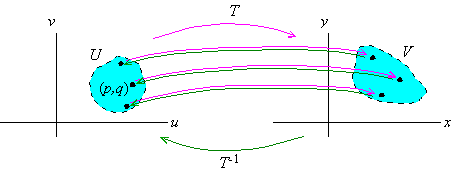The Inverse Function Theorem
Recall that if a coordinate transformation T maps an open region U in the uv-plane to
an open region V in the xy-plane, then T is 1-1 if each point in V is the image of only one point in U.
Additionally, if every point in V is the image under T(u,v) of at
least one point in U, then T(u,v) is said to map U onto V.
If T( u,v) is a 1-1 mapping of a region U in the uv-plane
onto a region V in the xy-plane, then we define the inverse
transformation of T from V onto U by
|
T-1( x,y) = ( u,v) only if (x,y) = T( u,v) |
|
The Jacobian determinant can be used to determine if T has an inverse
transformation T-1 on at least some small region about a given point.
Inverse Function Theorem: Let T( u,v) be a coordinate
transformation on an open region S in the uv-plane and let (p,q) be a point in S. If
|
|
¶( x,y)
¶( u,v)
|
ê
ê
|
( u,v) = ( p,q)
|
¹ 0 |
|
then there is an open region U containing ( p,q) and an open
region V containing ( x,y) = T( p,q) such that T-1 exists and maps V onto U.
The proof of the inverse function theorem follows from the fact that the Jacobian matrix of T-1(x,y), if it exists, is given by the inverse of the
Jacobian of T,
|
|
J-1( x,y) = |
 |
¶( x,y)
¶( u,v) |
 |
-1
|
é
ê
ë
|
|
|
ù
ú
û
|
|
|
|
which features a Jacobian determinant with a negative power (see the exercises).
Thus, J-1 exists only if the
determinant of J(u,v) is non-zero.
EXAMPLE 7 Where is T( r,q) =
á r cos(q), r sin(q)
ñ
invertible?
Solution: The Jacobian determinant for polar coordinates is
which is non-zero everywhere except the origin. Thus, at any point (r0,q0) with r0 > 0, there is an open region U in
the rq-plane and an open region V containing ( x,y) = ( r0cos( q0) ,r0sin( q0) ) such that T-1( x,y) exists and maps V onto U.
We will explore the result in example 7 more fully in the
exercises. In particular, we will show that
Clearly, T-1 is not defined on any open region containing (0,0) . Also, if y = 0 and x > 0, then
|
2tan-1 |
æ
ç
è
|
|
y
|
x+ |
 |
 |
|
| x2+02 |
|
|
|
|
ö
÷
ø
|
= 2tan-1 |
æ
è
|
|
0
x+ |x|
|
ö
ø
|
= 0 |
|
But if y = 0 and x < 0, then
|
2tan-1 |
æ
ç
è
|
|
y
|
x+ |
 |
 |
|
| x2+y2 |
|
|
|
|
ö
÷
ø
| |
= 2tan-1 |
æ
è
|
|
0
x+| x|
|
ö
ø
|
= 2tan-1 |
æ
è
|
|
0
0
|
ö
ø
|
|
|
That is, a different representation of T-1 must be used on any region which intersects the negative real axis.

